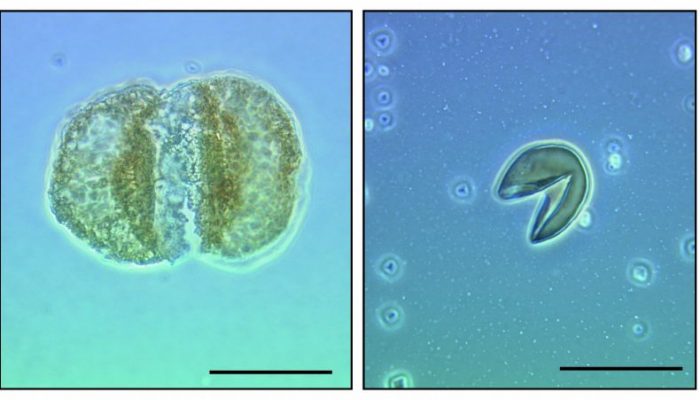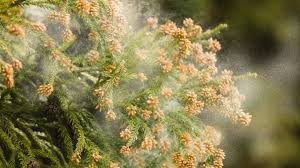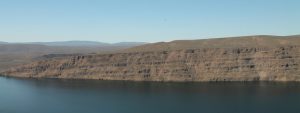
Pollen – for many people rather an irritant across spring, summer and autumn when trees and flowers are in bloom. Individual pollen grains are between a few µm (micrometre, which is one thousandth of an mm) and >130 µm in diameter. This size range is impossible to see with the naked eye unless the pollen grains are clumped together, or when pollen is dispersed as powder into the air on a dry summer day. When observed under the microscope, pollen display a complex and beautiful surface patterns (called sculpture) specific to each plant species. The study of pollen is also referred to as palynology.
Despite causing sore throats, sneezing and itchy eyes, pollen may be of great scientific and forensic importance! Pollen is the male part of the reproductive system of seed plants. During pollination, the pollen grows a tube down the ovary of the female part of the flower, and sends male sperm cells to the ovule (egg). Each plant species produces its very own type of pollen of distinctive size and shape. The number of pollen grains produced by a plant during the flowering season is immense. For example, it is estimated that the flower head of an average grass produces up to 10 million pollen grains.
While numerous plants are widely distributed there are plants that have a distinctive local occurrence. These pollen easily gets stuck at our clothing. This is where pollen becomes a useful tool in tracking down people or objects in forensics. Despite forensic palynology, pollen are widely used in biology, archaeology, and palaeontology, to better understand vegetation patterns, dynamics and ecosystems. The field of palynology, however, does not only include pollen, but all types of “palynomorphs”, such as spores (produced by ferns, mosses, algae and fungi), and dinocysts, which form part of the lifecycle of dinoflagellates (marine and freshwater plankton).
As a palaeopalynologist, I am interested in the fossil record of palynomorphs. In my research, I am looking at the palynological record of Cenozoic fluvial and lacustrine strata. In our palynological lab at the University of Aberdeen we use a range of acid treatments, particularly hydrofluoric acid treatment, to extract palynomorphs from the rock samples. The resultant solution is pipetted onto a slide, dried up and covered up to produce a palynological slide for examination under the microscope.
The examination of such palynological slides may be time consuming, however, systematic recording of the various abundant palynological taxa produces a great data set that allows me to reconstruct ancient vegetation patterns, communities and habitats. I commonly combine the palynological data with sedimentological and geochemical data to analyse how the vegetation interacted with its surrounding environment. Studying such palaeo-environments gives us the opportunity to get insights in how ecosystems developed over long-term, geological time scales.
For instance, as part of my post-graduate studies of the Columbia River Flood Basalt Province (CRBP) in Washington State, USA – a large volcanic terrain that was active between 17 and 6 My ago, I assessed how the ancient plant ecosystem was affected by volcanic eruptions and lava flow emplacement. The CRBP, however, has a particular geological setting, and is associated with more explosive volcanism of the adjacent Yellowstone hotspot and Cascade Range volcanism. In particular ancient Yellowstone volcanoes have spread large amounts of volcanic ash towards the CRBP over millions of years. Integrating the palynological record from the CRBP sedimentary intervals with analyses of volcanic ash deposits, we concluded that the ecological succession of CRBP plant communities was frequently disrupted by the external Yellowstone ashes, rather than internal CRBP volcanism (Ebinghaus et al. 2015*).
Large igneous province (LIP) volcanism like the CRBP is understood to have had significant impact on the environment within the vicinity of the volcanic centre. However, in comparison to other large igneous province, such as the Deccan LIP (India) and Siberian Traps (Russia), which are considered to have triggered major mass extinction events, the CRBP is a relatively “small” LIP. This may explain why the geologically continuous CRBP volcanism did not disrupt the plant ecosystem in such an extent as the more instant and explosive Yellowstone volcanism, thus causing less ecological impact.
Although not widely taught in undergraduate geoscience programmes, palynology is a useful tool to not only study past plant ecosystems, but also how environments responded to major stress factors such as volcanism. Its application in forensic science demonstrates the wider applicability of pollen studies. And maybe during the next flowering season one may imagine (hopefully without hay fever!) the transport and depositional history millions of pollen and spores have ahead and what they may tell about our environment sometime in the future.
*Ebinghaus, A; Jolley, D.W., and Hartley A.J. (2015): Extrinsic forcing of plant ecosystems in a large igneous province: The Columbia River flood basalt province, Washington State, USA. Geology, v. 43, no. 12, p. 1107 – 1110. doi:10.1130/G37276.1.



Pingback: Stratigraphy, Sedimentology and Palaeontology | The microworld of the past